|
|
|
|
|
|
|
Floors restored at Stryker Depot Thanks to the financial help of a local family and the Village of Stryker along with some pieces of wood with local significance, the floors of the Stryker train depot have been restored and are ready for new generations to enjoy the site. The Stryker Area Heritage Council opened the depot during the Stryker Summerfest so people could see how the floors looked.. Kirk Eichler (second from left) and his wife, LouAnne Eichler (third from left) are shown presenting a check to help pay for the floor restoration work done recently at the Stryker depot. Pictured from left to right are: Kent Juillard, SAHC Trustee; Kirk Eichler; LouAnne Eichler; Phil Short, SAHC Trustee; Erik Short, SAHC member; and Kenny Imm of Kenny’s Home Specialties, who did the floor restoration work. The Stryker Area Heritage Council has been preparing the depot for use as a heritage center ever since they first signed a lease with the Village of Stryker in August of 2008. As the council trustees held their monthly meetings in the building, they noted that the floor on the east side of the depot was made of wood, likely the original flooring. However, the floors on the west side were covered with carpeting that had outlasted its usefulness. Stryker Area Heritage Council trustee Phil Short, who has been leading the work done on the building with fellow SAHC trustee Kent Juillard and SAHC member Erik Short, said the problem was that no one knew what was under the carpet. He said the trustees hoped that the floor under the carpet was the same original wooden floor, perhaps covered by a protective subflooring cover. They suspected if they removed the carpet, they might be able to find the original flooring, and return the building to the way it looked years ago. The trustees decided it was worth the try. After pulling up the carpet and the subflooring, Phil, Kent and Erik found that their suspicions were correct. The wooden floor remained just as it had for many years before. It had years of grime and had lost any protective coating it may have once had, but it was still intact. Two additional work days were then held to remove the thousands of staples that had held the subflooring in place. In the meantime, Kirk and LouAnne Eichler contacted Phil with the offer of a donation to help cover the costs of the restoring the floor to look more like it may have looked early in its history. In making the contribution to the council, Mr. Eichler said, “The donation from the Eichler family is to restore the floors of the depot so we can preserve the heritage of Stryker.” When Phil and Kent attended a Stryker Village Council meeting to report on the planned restoration, the council pledged to match the donation so the project could be completed. The combination of the two donations now made it possible to not only restore the flooring on the west side of the building, but the east side as well. The donations also allowed the group to replace some trim around the floor and do some repair work around the registers that completed the floor project. However, there was one final obstacle. There was also a hole in the flooring of the east side of the building that needed to be repaired, and the group wondered how best to repair it. SAHC trustee Don Allison had the solution. He offered some floorboards that came from the 1920 Stryker High School study hall floor to fill in the area of the hole. The floorboards ended up being a good match to the depot floor, and the trustees liked the idea that the repair work would be done with boards that also have a historic tie to the community. Kenny Imm from Kenny’s Home Specialities of Edgerton did the restoration work on the floors, sanding the wood and covering the floor with stain and a couple coats of varnish. With the help of some volunteers, he was able to do the work in two stages, moving all the contents of the building to one side while refinishing the other and then reversing it to complete the other side. SAHC President Rose Burkholder said the floor restoration is a major step in preparing the depot to become a historic museum for the community. A copy of the museum planning document can be downloaded from the SAHC website. The council members are pleased to have the work on the floors completed, and opened the doors of the depot after the Stryker Summerfest parade so that anyone interested could see the work that was done. For more information about the work being done at the depot and for the preservation of history of the Stryker area, check the SAHC website at www.strykerahc.org.
Stryker Area Heritage Council members meet with state officials on depot museum Two officials of the Ohio Historical Society who provide outreach and historic preservation services around the state met with members of the Stryker Area Heritage Council to discuss how to best develop the depot into a museum.
He and Andy Verhoff, Local History Coordinator of the Local History Office of the state society, joined the Stryker heritage council members in a tour of the depot. Both had high praise for the rich wood interior of the building and understood why the community would like to see the structure preserved and used as a museum. They next began collecting the ideas council members had for activities in the depot. Most of the members said they felt that, due to the size of the depot, they would mostly display items pertaining to Stryker and house the rest in an adjoining room. They expect to change the displays periodically, rotating the items being housed into the displays. Most felt that there would not be enough space to also hold educational sessions or lectures in the depot once the displays are put in. SAHC Collections Committee Chairman Fred Grisier said he is afraid the council may be deluged with items once they begin accepting them, and could soon run out of space. Mr. Blankenship congratulated the members for making considerations about their collections before starting the museum’s development. Too many times, Mr. Blankenship pointed out, groups open their doors and take items without planning as to what they need and how they are going to care for the items once they get them. That can lead to situations where they have so many items that some are never displayed, and that a museum may not end up with items they would like to own or show. He encouraged the Stryker council members to think about the items or subjects of items they would like to collect. He also suggested the collections policy be expanded to require that the full committee decide on items to be accepted. That would allow the group to be more intentional about the items they receive. Mr. Verhoff pointed out that once they accept an item, they have it forever. There should be some thought into how the item will be cared for during that time. “Environment is important,” Mr. Blankenship added. “Variations in temperature and humidity can affect items greatly. They handle things best when those stay at a consistent level.” Controlling the environment and getting insurance coverage for the building contents are added costs for the council. Mr. Verhoff suggested asking those who donate items to also make a financial contribution to ensure the item or items can be preserved for the years to come. The group touched on how to best exhibit items. While metal shelving with an inert covering is preferred, Blankenship wondered if there were any cabinet makers in the area who might assist the council with their exhibits. He suggested the council get a computer with software that can catalog their inventory, as well as to keep backup copies off site of the depot. He also encouraged the council to make plans of what to do with their collection in disaster situations, such as how they might respond if a natural disaster, loss of utilities or water line break might occur. The subject of volunteers came up. Most agreed that volunteer help would be needed to catalog and display items and to meet with visitors to the museum who would like to know more about the history of the Stryker area. “This is a big undertaking,” Mr. Blankenship said. “Some groups do this, and their focus turns inward. Everything becomes about the museum.” Several of the Stryker council members said they hoped that the museum would put on special shows and collections from time to time and join in with special promotions in the community, but also felt that the outside programs and lectures should continue to be provided. The two state officials will take the responses of the council members back with them to their office in Columbus, and provide a plan, auxiliary information and suggestions on how the Stryker heritage council members may proceed with the project.
Video of driving tour being shown in the area Ever wonder how the family for whom Goll Woods is named came to the area, and why is their barn so unique? Do you know what thriving business used to be in Lockport or that there was a large business built upon selling trees to settlers southwest of Stryker? Is it true that there’s a favorite place for skinny-dipping in Evansport, or is it two? These and other questions about the history of the area are answered in a new video just released by the Stryker Area Heritage Council. The video, which is being shown by area cable outlets, is based on a historic driving tour the Council sponsored two years ago. “The original idea was to record and then replay the driving tour in 2006,” says Bill Priest who produced the new video. “But there were some glitches with the original recording, and it looked like it wasn’t going to work.” Instead of letting it go, Mr. Priest contacted the presenters and asked them to reshoot some of the segments. He noted that the farther the group got into the project, the more they saw that they wanted to add to it. So, by taking the extra time, they were able to add interesting information that wasn’t presented on the tour. The tour begins at the Goll family homestead and barn, travels to Evansport, then to the Pine Grove Mennonite Church, that also used to be the site of the Stryker Nurseries. There is a stop at the ghost town Williamsport, which would have grown up around where the Boynton Cemetery is now had the town flourished, then the Prayer Chapel, which used to be the Oak Grove Methodist Episcopal Church. The tour ends at the Evansport mill. “There are clips of the original tour in the show…complete with the sound of wind and cars driving by,” Priest laughs. “But along with that, some of the presenters came back and redid their segments, expanding on what they said.” “That’s what really makes the show, the historians who delved into the backgrounds of their topics,” Priest notes. Presenters include Kris Jemmott, Don Julliard and Pete Wilhelm at the Goll homestead and barn, Tonya Bockover at Lockport, Kevin Maynard at the Stryker locations, Sue Buehrer at the former Oak Grove church and Jean (Coy) Bartholomew and Tanya Brunner at Evansport. Several area cables outlets aired the program, and may rebroadcast it from time to time. Check your local listings. Copies of the program are available at SAHC events for $10 a copy for members or $12 for non-members. They should also be available soon in the SAHC website store.
We’re STILL looking for a few good yearbooks!
The SAHC supplemented the extensive yearbook collection housed at the Williams County Public Library’s Stryker branch by donating copies of the 2001, 2002, 2004, 2005, 2007 and 2008 editions. In addition, a 1961 “Panthian” was given by Betty Beck, Stryker, and Terry Perkins, Stryker, donated a 1968 annual. “Panthians” needed to complete the set include 1940 and earlier editions, as well as 1942, 1943, 1944, 1945. 1946, 1956, 1989, 2001, 2002, 2003, 2006 and 2009 editions. Anyone willing to donate a copy of these “Panthians” to the Library’s collection may contact the SAHC at P.O. Box 180, Stryker, OH 43557 or via email at info@strykerahc.org. Pictured are SAHC representatives Helen Bell and Sue Buehrer, Library staff member Luanne Hogle, and SAHC President Terry Perkins.
New book displays Williams County history through photos The pictorial history, “Images of America: Williams County,” received an enthusiastic response to its official unveiling at the Stryker Area Heritage Council’s Fourth Annual General Membership Meeting November 25. Author Kevin Maynard was the meeting’s featured speaker and presented images from the publication and the stories behind the historic photographs. Mr. Maynard explained the history captured in the representative photos from the 128-page softcover book. More than 200 vintage black and white images, many of which have never appeared in local history books, are featured in the book and arranged according to sections, Mr. Maynard said. There is also a companion piece, “Postcards of America: Williams County,” consisting of 15 photographs selected from the book, accompanied by historic information.
From SAHC eNews December 2008
SAHC has much to celebrate at Fourth General Meeting The Stryker Area Heritage Council conducted its Fourth Annual General Membership Meeting on November 25 at the Stryker American Legion Hall with 49 members and guests in attendance. President Terry Perkins called the meeting to order and then introduced Stryker Village Council Member Erik Short. After welcoming those in attendance, Mr. Short said, “ “Without an understanding of how far we have come,” Mr. Short continued, ”as well as the hard work and dedication that it took to get us here, we can’t fully appreciate all of the many wonderful blessings we enjoy today. The Stryker Area Heritage Council has done a remarkable job of providing us with this perspective through its publications, website, activities and scholarly lectures by experts in their various fields.”
SAHC Board Member Bill Priest offered the invocation, followed by presentation of the United States flag by Stryker Troop 79 Boy Scouts of America, who led the group in the Pledge of Allegiance. President Perkins presented the minutes of the Third Annual General Membership Meeting held on November 1, 2007, for consideration, which were approved by the members in attendance.
Treasurer Sue Buehrer presented the SAHC’s annual financial report and shared highlights of the last year’s operations with the members in attendance. President Perkins presented an overview of the Stryker Area Heritage Council’s 2008 activities and accomplishments, including the following:
• Sponsored Don Allison’s “Hell on Belle Isle” Civil War POW book presentation in March. • Commemorated John Stryker’s 200th birthday, assisted with the parade, and hosted a local history panel discussion at the 2008 Stryker Summerfest. • Sponsored Mark Kelly’s “Williams County Murders” presentation in September. • Sponsored publication of “Images of America: Williams County” and “Postcards of America: Williams County” in November. • Sponsored Randy Buchman’s “A Sorrowful Journey” book presentation in October. • Issued wooden replicas of the 1922 Stryker High School. • Executed a lease with the Village of Stryker in August to create a museum in the Stryker depot. • Prepared three new local history brochures. • Produced DVDs of the 2008 Stryker Summerfest local history panel. • Added a “Historic Photo of the Month” feature to the SAHC website.
Keynote speaker Kevin Maynard presented a program on his new pictorial history, “Images of America: Williams County,” and autographed copies of the book for interested attendees. Several displays of old Stryker school annuals, newspapers and memorabilia were put on by SAHC members for the enjoyment of those in attedance. From SAHC eNews December 2008
Member of Stryker Class of ‘26 cuts the ribbon on new school
SAHC and Village Ink Depot Museum Lease
Replicas of 1922 High School have proven popular
The SAHC sold all of the first 100 numbered limited edition wooden replicas of the historic high school building soo n after they were released, and so they placed a second order.
Civil War POW Life Described in SAHC Program at Stryker Legion The discovery of a diary of a local man who was a POW during the Civil War led a local author to search into his story and ended with the writing of a book about his memoirs. Holiday Happenings Event Featured Stryker-Made Toys Stryker’s annual community Holiday Happenings event November 26 had an historic “Made in Stryker” flavor this year. Through the courtesy of the Ohio Art Company, the Stryker Area Heritage Council presented a special holiday display at the Stryker depot featuring toys manufactured at the former Strydel/Emenee plant. Pictured here are Sue Buehrer, Kent Julliard and Chuck McCall showing some of the toys that were displayed. These toys surely brought back memories for many area residents. SAHC Receives IRS Tax-Exempt Designation The Internal Revenue Service has determined the Stryker Area Heritage Council meets the requirements of 501 (c)(3) tax-exempt organization status. |
|
©2011 Stryker Area Heritage Council All rights reserved |
|
[Home] [About] [Contact Us] [Events] [Evansport 175th] [Historic Photo] [Help Identify] [Home Research] [Membership] [Newsletter] [Latest News] [Lockport 175th] [Links] [Q & A] [Store] [Virtual Museum] |

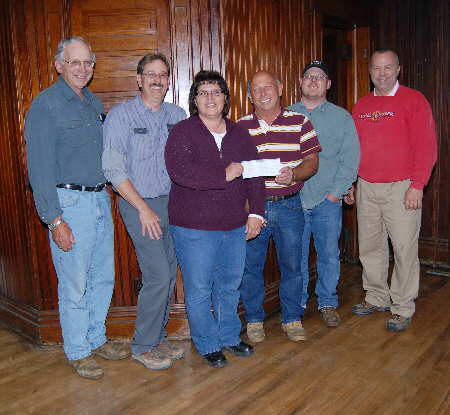
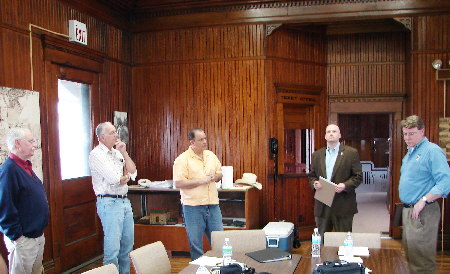 Meeting at the Stryker depot on Saturday (May 9), Jody Blankenship, Manager of Outreach & Field Services for the state historical society, began by congratulating the Stryker area group on the historical programs, publications and website operated by the council. He said the group is doing a fine job of providing education and outreach into the community.
Meeting at the Stryker depot on Saturday (May 9), Jody Blankenship, Manager of Outreach & Field Services for the state historical society, began by congratulating the Stryker area group on the historical programs, publications and website operated by the council. He said the group is doing a fine job of providing education and outreach into the community.
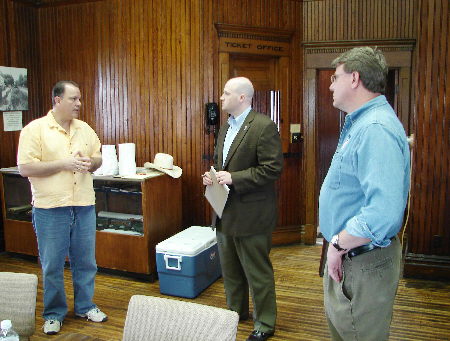
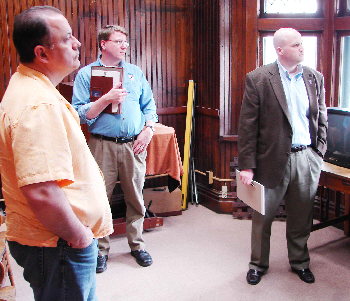
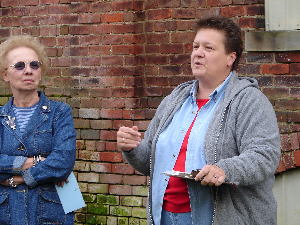
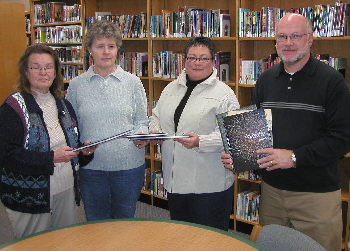 The Stryker Area Heritage Council continued its efforts to complete the set of Stryker High School “Panthian” yearbooks available for local history and genealogy research purposes with the recent donation of several needed copies.
The Stryker Area Heritage Council continued its efforts to complete the set of Stryker High School “Panthian” yearbooks available for local history and genealogy research purposes with the recent donation of several needed copies.
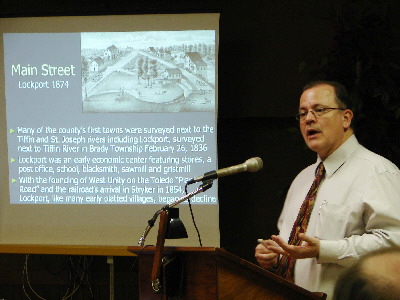
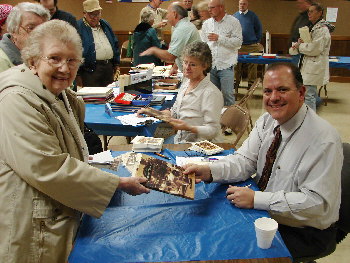 “These vintage images are mesmerizing, with a depth and detail unlike today’s photographs; they serve as virtual windows to the past, transporting you to a different time and capturing the essence of what life was once like,” Maynard said.
“These vintage images are mesmerizing, with a depth and detail unlike today’s photographs; they serve as virtual windows to the past, transporting you to a different time and capturing the essence of what life was once like,” Maynard said. 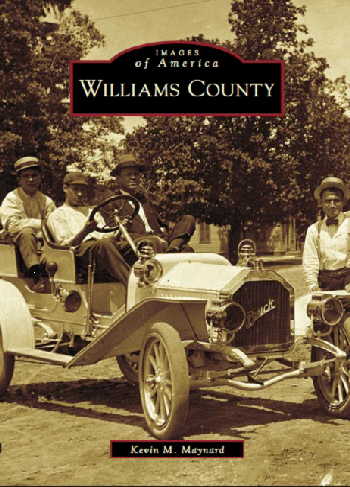 Mr. Maynard is a Stryker High School graduate and holds an Associate’s Degree in Electromechanical Engineering from Northwest State Community College and a Bachelor’s Degree in Business Administration from The Defiance College.
Mr. Maynard is a Stryker High School graduate and holds an Associate’s Degree in Electromechanical Engineering from Northwest State Community College and a Bachelor’s Degree in Business Administration from The Defiance College. 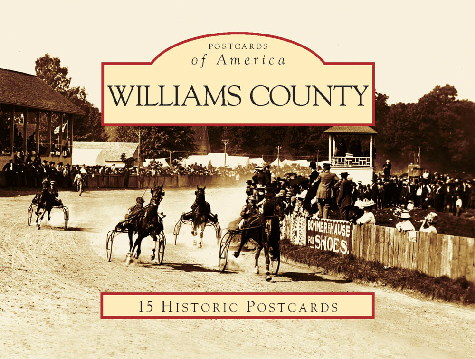 Copies may be purchased by mailing a check or money order, payable to the Stryker Area Heritage Council, to Kevin Maynard, 1436 Muirfield Drive, Bowling Green, OH 43402. “Images of America: Williams County is priced at $20 for SAHC members ($21.99 for non-members) plus $4 per book shipping. The accompanying “Postcards of America: Williams County” is priced at $7 for SAHC members ($7.99 for non-members) plus $2 shipping per postcard set. As you might guess, both make wonderful holiday gifts or stocking stuffers!
Copies may be purchased by mailing a check or money order, payable to the Stryker Area Heritage Council, to Kevin Maynard, 1436 Muirfield Drive, Bowling Green, OH 43402. “Images of America: Williams County is priced at $20 for SAHC members ($21.99 for non-members) plus $4 per book shipping. The accompanying “Postcards of America: Williams County” is priced at $7 for SAHC members ($7.99 for non-members) plus $2 shipping per postcard set. As you might guess, both make wonderful holiday gifts or stocking stuffers!
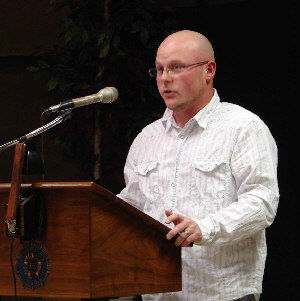 Our community has many positive things to celebrate this year, including completion of a beautiful new junior high and high school facility, continuing development of the Knight’s Landing recreation area on the Tiffin River north of town, and execution of a lease with the Stryker Area Heritage Council to develop a museum in the former New York Central Railroad passenger depot, a structure listed on the National Register of Historic Places.”
Our community has many positive things to celebrate this year, including completion of a beautiful new junior high and high school facility, continuing development of the Knight’s Landing recreation area on the Tiffin River north of town, and execution of a lease with the Stryker Area Heritage Council to develop a museum in the former New York Central Railroad passenger depot, a structure listed on the National Register of Historic Places.”
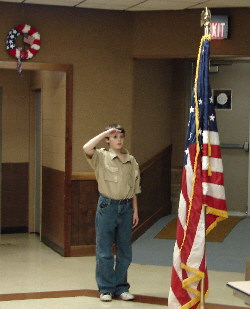 “We salute the fine work of the Stryker Area Heritage Council’s board of trustees and members, and encourage you to support the organization’s work by joining or renewing your membership and by becoming involved in the Heritage Council’s activities.Your community is what you make of it, and when like-minded people unite for a common good, there’s nothing we can’t accomplish.” Mr. Short concluded.
“We salute the fine work of the Stryker Area Heritage Council’s board of trustees and members, and encourage you to support the organization’s work by joining or renewing your membership and by becoming involved in the Heritage Council’s activities.Your community is what you make of it, and when like-minded people unite for a common good, there’s nothing we can’t accomplish.” Mr. Short concluded.
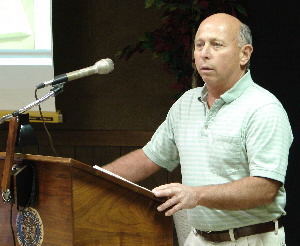 Board Development Committee member Phil Short presented the following list of candidates to serve on the SAHC’s Board of Trustees from 2009 through 2011: Kent Juillard, Kevin Maynard and Terry Perkins, and also called for nominations from the floor. With no further nominations, the proposed slate of trustees was approved by acclamation.
Board Development Committee member Phil Short presented the following list of candidates to serve on the SAHC’s Board of Trustees from 2009 through 2011: Kent Juillard, Kevin Maynard and Terry Perkins, and also called for nominations from the floor. With no further nominations, the proposed slate of trustees was approved by acclamation.
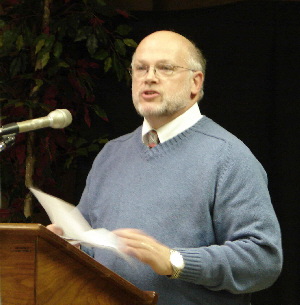 • The 2007 Holiday Happenings event featured S t r y d e l / E m e n e e toys, music, a working model railroad layout and other displays at the Stryker depot.
• The 2007 Holiday Happenings event featured S t r y d e l / E m e n e e toys, music, a working model railroad layout and other displays at the Stryker depot.
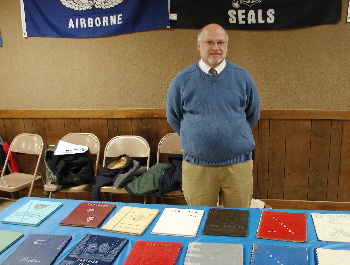 • Placed books of local historic interest in the Stryker and Bryan libraries.
• Placed books of local historic interest in the Stryker and Bryan libraries.
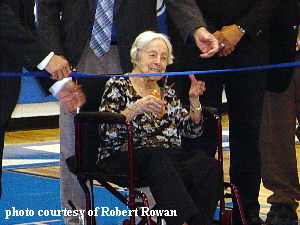 Congratulations to Ruby Hall, 101-year-young Stryker resident, who cut the ribbon at the dedication of the new Stryker Junior High and High School Building in August 24! Ruby is the only remaining member of the Stryker Class of 1926, and the oldest living graduate of the school. With tears of pride, she cut the ribbon at the dedication before a packed crowd of wellwishers from the community.
Congratulations to Ruby Hall, 101-year-young Stryker resident, who cut the ribbon at the dedication of the new Stryker Junior High and High School Building in August 24! Ruby is the only remaining member of the Stryker Class of 1926, and the oldest living graduate of the school. With tears of pride, she cut the ribbon at the dedication before a packed crowd of wellwishers from the community.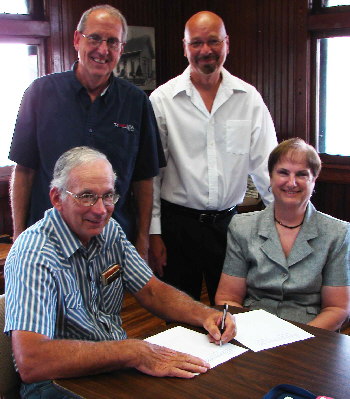 An historic step was taken August 14 when representatives of the Stryker Area Heritage Council and the Village of Stryker executed a lease agreement that will allow the SAHC to develop and operate a museum in Stryker's historic railroad passenger depot.
An historic step was taken August 14 when representatives of the Stryker Area Heritage Council and the Village of Stryker executed a lease agreement that will allow the SAHC to develop and operate a museum in Stryker's historic railroad passenger depot.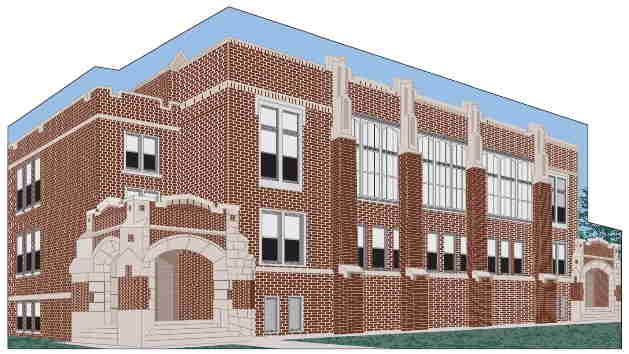
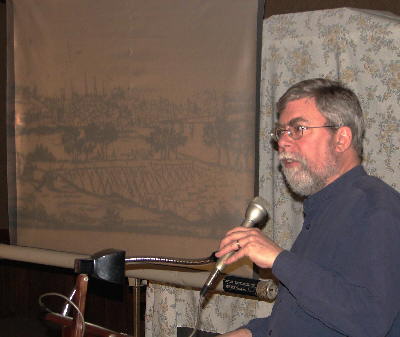
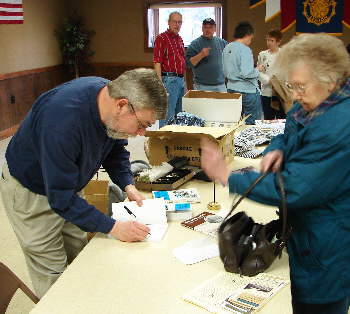 Reduced to a walking skeleton by his ordeal, Coburn died in a Richmond hospital on March 8, 1864, a victim of starvation and chronic diarrhea. He was one of 40,000 Union soldiers who lost their lives as a POW, Allison said.
Reduced to a walking skeleton by his ordeal, Coburn died in a Richmond hospital on March 8, 1864, a victim of starvation and chronic diarrhea. He was one of 40,000 Union soldiers who lost their lives as a POW, Allison said.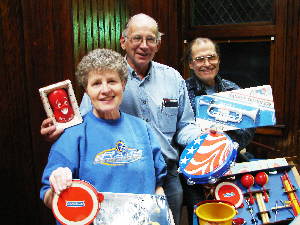
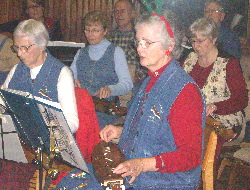 Those who peered in the former ticket office of the depot found a real treat: Chuck McCall had set up an “O” gauge railroad train set and it was winding its way through a couple of small towns in the loop.
Those who peered in the former ticket office of the depot found a real treat: Chuck McCall had set up an “O” gauge railroad train set and it was winding its way through a couple of small towns in the loop.